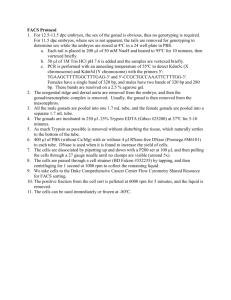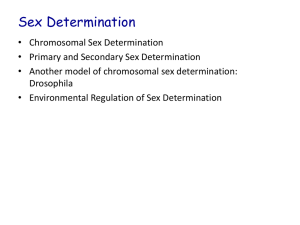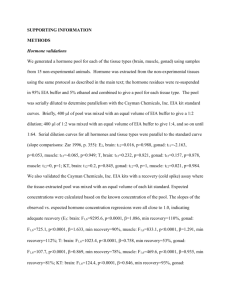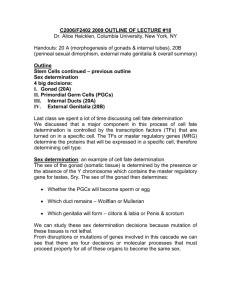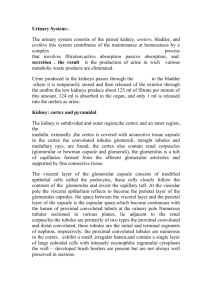15 Holothuria scabra Mélanie Demeuldre and Igor Eeckhaut
advertisement
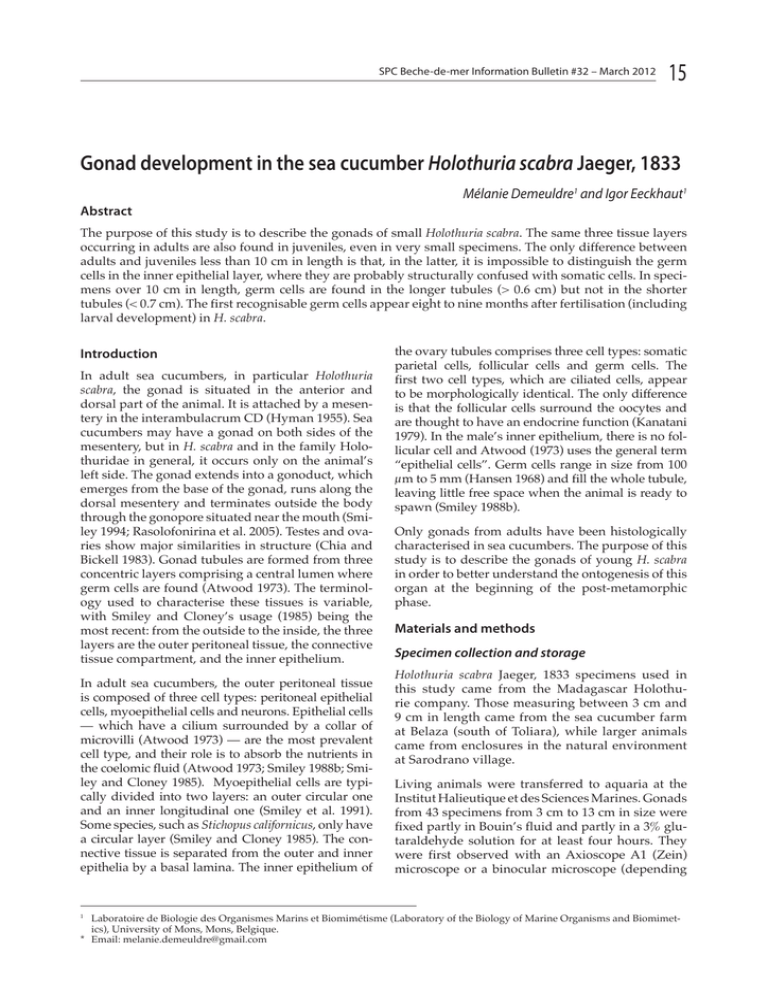
SPC Beche-de-mer Information Bulletin #32 – March 2012 15 Gonad development in the sea cucumber Holothuria scabra Jaeger, 1833 Mélanie Demeuldre1 and Igor Eeckhaut1 Abstract The purpose of this study is to describe the gonads of small Holothuria scabra. The same three tissue layers occurring in adults are also found in juveniles, even in very small specimens. The only difference between adults and juveniles less than 10 cm in length is that, in the latter, it is impossible to distinguish the germ cells in the inner epithelial layer, where they are probably structurally confused with somatic cells. In specimens over 10 cm in length, germ cells are found in the longer tubules (> 0.6 cm) but not in the shorter tubules (< 0.7 cm). The first recognisable germ cells appear eight to nine months after fertilisation (including larval development) in H. scabra. Introduction In adult sea cucumbers, in particular Holothuria scabra, the gonad is situated in the anterior and dorsal part of the animal. It is attached by a mesentery in the interambulacrum CD (Hyman 1955). Sea cucumbers may have a gonad on both sides of the mesentery, but in H. scabra and in the family Holothuridae in general, it occurs only on the animal’s left side. The gonad extends into a gonoduct, which emerges from the base of the gonad, runs along the dorsal mesentery and terminates outside the body through the gonopore situated near the mouth (Smiley 1994; Rasolofonirina et al. 2005). Testes and ovaries show major similarities in structure (Chia and Bickell 1983). Gonad tubules are formed from three concentric layers comprising a central lumen where germ cells are found (Atwood 1973). The terminology used to characterise these tissues is variable, with Smiley and Cloney’s usage (1985) being the most recent: from the outside to the inside, the three layers are the outer peritoneal tissue, the connective tissue compartment, and the inner epithelium. In adult sea cucumbers, the outer peritoneal tissue is composed of three cell types: peritoneal epithelial cells, myoepithelial cells and neurons. Epithelial cells — which have a cilium surrounded by a collar of microvilli (Atwood 1973) — are the most prevalent cell type, and their role is to absorb the nutrients in the coelomic fluid (Atwood 1973; Smiley 1988b; Smiley and Cloney 1985). Myoepithelial cells are typically divided into two layers: an outer circular one and an inner longitudinal one (Smiley et al. 1991). Some species, such as Stichopus californicus, only have a circular layer (Smiley and Cloney 1985). The connective tissue is separated from the outer and inner epithelia by a basal lamina. The inner epithelium of the ovary tubules comprises three cell types: somatic parietal cells, follicular cells and germ cells. The first two cell types, which are ciliated cells, appear to be morphologically identical. The only difference is that the follicular cells surround the oocytes and are thought to have an endocrine function (Kanatani 1979). In the male’s inner epithelium, there is no follicular cell and Atwood (1973) uses the general term “epithelial cells”. Germ cells range in size from 100 μm to 5 mm (Hansen 1968) and fill the whole tubule, leaving little free space when the animal is ready to spawn (Smiley 1988b). Only gonads from adults have been histologically characterised in sea cucumbers. The purpose of this study is to describe the gonads of young H. scabra in order to better understand the ontogenesis of this organ at the beginning of the post-metamorphic phase. Materials and methods Specimen collection and storage Holothuria scabra Jaeger, 1833 specimens used in this study came from the Madagascar Holothurie company. Those measuring between 3 cm and 9 cm in length came from the sea cucumber farm at Belaza (south of Toliara), while larger animals came from enclosures in the natural environment at Sarodrano village. Living animals were transferred to aquaria at the Institut Halieutique et des Sciences Marines. Gonads from 43 specimens from 3 cm to 13 cm in size were fixed partly in Bouin’s fluid and partly in a 3% glutaraldehyde solution for at least four hours. They were first observed with an Axioscope A1 (Zein) microscope or a binocular microscope (depending Laboratoire de Biologie des Organismes Marins et Biomimétisme (Laboratory of the Biology of Marine Organisms and Biomimetics), University of Mons, Mons, Belgique. * Email: melanie.demeuldre@gmail.com 1 16 SPC Beche-de-mer Information Bulletin #32 – March 2012 on the size of the gonad) and photographed, before any other form of treatment. Scanning electron microscopy Entire gonads from sea cucumbers 3–7 cm long, and fractions of gonads from sea cucumbers 10–13 cm long were prepared for observation under a scanning electron microscope. Samples fixed in Bouin’s fluid were stored in 70% ethanol. After being dehydrated in graded alcohol baths (70%, 90% and 100% ethanol), they were dried using a Polaron critical point dryer. They were then placed on aluminium stubs to be coated with gold in a JEOL JFC-1100E sputter-coater for five minutes. After these steps, samples were observed with a JEOL JSM-6100 scanning electron microscope. Samples placed in glutaraldehyde were rinsed three times for 10 minutes in a rinsing solution of 0.2 M sodium cacodylate. They were then postfixed for one hour in a 1% osmium tetroxide solution. After three rinses, samples were dehydrated in a series of graded ethanol baths (25%, 50%, 70%, 90% and 100% ethanol). Drying and metallisation steps were identical to those used for samples placed in Bouin’s fluid. by a mesentery. Each gonad tubule is formed from a primary branch and a number of subsidiary branches of various types called secondary, tertiary branches, etc., up to the apex of the gonad tubule. Dichotomisations are referred to as being primary, secondary or tertiary if they give origin to secondary, tertiary and quaternary branches, respectively. The branch situated above the gonad apex is also called the terminal branch. Gonad tubules may show either of two types of dichotomisation (Figs. 1 and 2). Symmetrical dichotomisation (Figs. 1 and 2 A, B) involves the parent branch dividing into two offshoots, each having an identical diameter. Asymmetrical dichotomisation (Figs. 1 and 2 C, D) occurs when a parent branch gives birth to two offshoots of varying diameters, one of which has a diameter almost equivalent to that of the parent branch. Infrequently, tubules form trichotomies and not dichotomies (Fig. 1 C). Semi-thin sections Some samples placed in the glutaraldehyde were rinsed, post-fixed and dehydrated in the same way as for the scanning electron microscope examination, but embedded in Spurr resin. They were then placed for 24 hours at 70°C. Semi-thin sections (1 μm thick) were performed by using a Reichert Austria U2 microtome with a glass knife. These sections were hot-stained using a mixture of equivalent volumes of 1% methylene blue and 1% Azur II for 30 seconds and then observed using the Axioscope A1 (Zein) microscope. Results The gonad, whether male or female, has a base from which gonad tubules run, and from which emerges the gonoduct, running along the anterior part of the digestive tube, to which it is attached Figure 1. Photos by scanning electron microscopy (SEM) of Holothuria scabra gonads. Plate showing the dichotomisation of gonad tubules. A: Portion of the gonad of a specimen 11 cm long showing the two possible types of dichotomisation: symmetrical (2) and asymmetrical (1) (Scale: 1 mm) B: Gonad tubule showing a dichotomy (Scale: 100 μm) C: Gonad tubule showing a trichotomy (Scale: 100 μm) SPC Beche-de-mer Information Bulletin #32 – March 2012 Primary branch Secondary branch Tertiary branch Quaternary branch etc. Symmetrical dichotomy Primary branch ◊ ◊ Secondary branch ◊ ◊ Tertiary branch Quaternary branch ◊ Symmetrical dichotomy Asymmetrical dichotomy Figure 2. Plate showing the two types of dichotomy found in gonad tubules. 1: Primary branch; 2: Secondary branch; 3: Tertiary banch; 4 : Quaternary branch. A: Diagram representing symmetrical dichotomy B: Photo representing symmetrical dichotomy (Scale: 200 μm) C: Diagram representing asymmetrical dichotomy (represented by ) — the first and last dichotomy (represented by ) are symmetrical dichotomies D: Photo representing asymmetrical dichotomy — the first and last dichotomies are symmetrical (Scale: 200 μm) • ◊ 17 18 SPC Beche-de-mer Information Bulletin #32 – March 2012 Figure 3. Plate representing gonads of specimens of species H. scabra of varying lengths from 3 cm in Photo A to 12 cm in Photo F. B: base of the gonad; D: dichotomisation; T: gonad tubule. Scale: 200 μm (A–E) and 0.3 cm (F–G). Photos taken by an optical microscope of the gonad of a specimen: A: 3.3 cm in length; B: 4 cm in length; C: 5.5 cm in length; D: 7 cm in length; and E: 8.8 cm in length The gonad in specimens 3 cm long (Fig. 3 A) comprises less than five tubules, some of which are dichotomised but are formed only from primary and secondary tubules. Figure 3 A portrays a gonad with a gonad tubule (the longest) showing symmetrical dichotomy. The primary branch of this gonad tubule is 60 μm in diameter and 250 μm long, while the secondary branch, which is 5 μm long, leads into a tubule apex resembling a sphere with a diameter of 100 μm. The gonad of specimens 4 cm long (Fig 3 B) has 5–10 gonad tubules; 7 of which are present on the specimen shown in Figure 3 B. Most gonad tubules are not dichotomised but when they are, the dichotomy only gives birth to secondary branches. The longest measured tubule was 900 μm and the shortest was 100 μm. The diameter was 70 μm. Each tubule terminates in a tubule apex 100 μm in diameter. SPC Beche-de-mer Information Bulletin #32 – March 2012 19 Figure 4. Details of gonads of Holothuria scabra. B: base of the gonad; L: lumen of the gonad tubule; T: gonad tubule. A: B: C: D: Base of the gonad in a specimen 7 cm long (Scale: 100 μm) Small tubules already showing dichotomy (Specimen 7 cm long) (Scale: 100 μm) Base of a gonad tubule in a specimen 7 cm long (Scale: 50 μm) Apex of the tubule of a gonad in a specimen 4 cm long (Scale: 20 μm) The gonad in specimens 5 to 9 cm long (Fig 3 C) has 10–20 tubules. The specimen shown in Figure 3 C is 5.5 cm long and has 17 tubules. The longest tubule measures 1.6 mm. A number of tubules show primary dichotomisation. The primary branch forms 90% of the total length of gonad tubule. The terminal branch, 70 μm in diameter, is short and directly followed by the tubule apex (100 μm in diameter). The gonads represented in Figures 3 D and E come from specimens between 7 cm and 8 cm in length. The number of gonad tubules connected to the base of the gonad was about 15. The length of primary branches (45%) exceeds that of secondary (11–34%) and tertiary (30%) branches. The tubule apex always measures some 100 μm in diameter while the tubule is 70 μm in diameter. Specimens measuring 7 cm have, at this length, a gonad where the tubules increase in length from one side of the gonad to the other. The gonad in specimens 9–11 cm long (Fig 3 F) comprises 20–60 tubules with a diameter of 1.2 mm. The gonad of the specimen illustrated in Figure 3 F measures 9.5 cm long and has 29 gonad tubules with a diameter of 2.0 mm. A larger proportion of tubules with tertiary branches are observed (52%). The diameter of a tubule is 150 μm at its extremity. The gonad of a dissected specimen 10.3 cm long (Fig 3 G) is formed from 55 tubules, some of which have quaternary branches. The highest proportion of tubules (42%) has tertiary branches. In Figure 4, some details of a gonad can be observed. Photo A focuses on the base of the gonad. The lumen of each tubule terminates in a common zone leading to the gonoduct. Photo B shows the dichotomisation of shorter tubules: even a 250 μm tubule shows dichotomisation. Photo C shows the tubule lumen at its base, which shows a slight swelling. Photo D is of the end of a tubule, and the tubule apex is visible. It has a diameter of 100 μm. In brief, when a gonad develops, the number and length of tubules increases, but the diameter does also. The tubule apex keeps its diameter even in gonads of larger specimens. Primary dichotomisations are found in juveniles more than 3 cm long. Tubule growth not only occurs at its extremity: primary and secondary branches of larger specimens are longer than those in smaller specimens. 20 SPC Beche-de-mer Information Bulletin #32 – March 2012 Figure 5. Photos by scanning electron microscopy of gonads of juvenile specimens of Holothuria scabra. C: cilia; D: dichotomisation; M: microvilli; T: gonad tubule; TD: digestive tube. A: B: C: D: Gonads were also observed by scanning electron microscopy. Figure 5 A illustrates a gonad from a specimen 3 cm long. The gonad tubules (of which one is dichotomised) converge towards the base attached to the mesentery of the digestive tube. The tubule apex has a diameter of 60 μm. Another gonad from a specimen 4 cm long is illustrated in Gonad of a specimen 3.3 cm long. (Scale: 100 μm) Gonad of a specimen 3.2 cm long (Scale: 100 μm) Detail of the extremity of a tubule apex (Scale: 10 μm) Cell forming the outer peritoneal tissue: epithelial cell (Scale: 1 μm) Figure 5 B. It is formed of 7 gonad tubules, with each tubule terminating in a tubule apex that is 60 μm in diameter (Fig. 5 C). The surface of gonads is uniformly ciliated. A cilium measures 11 μm in length and is encircled by a collar of microvilli that is 0.1 μm long. Each cilium is 2.2 μm distant from the next (Fig. 5 D). SPC Beche-de-mer Information Bulletin #32 – March 2012 21 Figure 6. Semi-thin sections in a gonad from a specimen 10 cm long. C: Cilia; CC: Connective cell; CE: Epithelial cells; CF: Follicle cell; CG: Germ cell; CO: Coelomocytes; CTC: compartment of connective tissue; M: muscle; TEI: Inner epithelial tissue; TPE: outer peritoneal tissue. A: B: C: D: General view of a circular section in a small-sized gonad tubule (Scale: 20 μm) Detail of the wall of a small-sized gonad tubule (Scale: 10 μm) General view of a circular section in a big-sized gonad tubule (Scale: 10 μm) Detail of the wall of a big-sized gonad tubule (Scale: 5 μm) Semi-thin sections enable comparison of small tubules (length < 0.6 cm; Figs. 6 A and B, and Fig. 7) with longer ones (length > 0.7 cm; Figs. 6 C and D, and Fig. 8) in the same specimen. This also makes it possible to conduct research on the histology of gonad tubules in small specimens (< 10 cm long). Germ cells (oocytes here) are only detected in large tubules, not in small ones. In the outer peritoneal tissue, ciliated epithelial cells are the most prevalent and, therefore, form the most common cell type. These cells measure 15 μm wide and 2.5 μm thick at their thinnest point. They have a cilium and a collar of microvilli. The nucleus is at the base of the cell. Some cells of the “cœlomocyte” type are shown in Figures 6 B and D. Their cytoplasm is filled with vesicles 2 μm in diameter. A circular muscular layer is also present (Fig 6 B). Nerves were not detected because of inadequate resolution. A basal lamina separates the outer epithelium from the connective tissue. In the connective tissue compartment there are some connective cells (Figs. 6 B and D) and the fibrous matrix. The innermost layer (inner epithelium), also delimited by a basal lamina, is the one that differs depending on the size of the tubules studied. In small gonad tubules of large specimens and in gonad tubules of small specimens (< 10 cm) (Fig. 6 B), only one cell type is identifiable — the inner epithelial cells — while for larger gonad tubules, germ cells and their follicular cells are also present (Fig 6 D). Epithelial cells are, in both cases, flat-shaped cells 15 μm wide and 0.5 μm thick. At this resolution, only apical microvilli have been observed. Follicular cells have the same structure and may enter into contact with epithelial cells. They wholly or partly cover the oocytes. 22 SPC Beche-de-mer Information Bulletin #32 – March 2012 Figure 7. Diagram representing the wall of a small-sized tubule (< 0.6 cm long). C: Cilia; CC: Connective cells; CE: Epithelial cells; CTC: compartment of connective tissue; LB: Basal lamina; M: Microvilli; Mu: Muscle; TEI: Inner epithelial tissue; TPE: outer peritoneal tissue. Figure 8. Diagram representing the wall of a large-sized tubule (> 0.7 cm long). C: Cilia; CC: Connective cells; CE: Epithelial cells; CF: Follicle cells; CG: germ cells; CTC: compartment of connective tissue; LB: Basal lamina; M: Microvilli; Mu: Muscle; TEI: Inner epithelial tissue; TPE: outer peritoneal tissue. Discussion and conclusion The annual development of adult sea cucumbers gonads has been described by Smiley (1988a), who suggested that there is an annual tubule recruitment event. In this model, gonad tubules are grouped into three cohorts: primary tubules (the smallest and most anterior of the tubules), secondary tubules (intermediate in position and size) and fertile tubules (the most posterior). Within each separate cohort, development is synchronous. If in year N, tubules are at the stage of primary tubules, in year N+1, these tubules will become secondary tubules and then, the following year, they will be fertile tubules. When tubules are empty after spawning, they shrink. Smiley’s model assumes that tubules of the same cohort are at the same stage and that fertile tubules shrink after spawning. Since the initial publication of this model by Smiley, a number of exceptions have been discovered and its applicability seems limited. This is thought to be the case with the sea cucumber H. scabra (Sewell et al. 1997). The gonad of H. scabra is not divided into several cohorts of tubules. Apart from the still immature smallest tubules, all tubules forming the specimen’s gonad are at the same stage of development. Within a given population, however, specimens are not all at the same stage (Ramofafia and Byrne 2001). For Ramofafia and Byrne (2001), the annual growth of a gonad is characterised by tubule growth (in size and number) but also by an increase in the number of ramifications. This increases the total volume of the gonad and, therefore, fertility. Large tubules can dichotomise up to two or three times, whereas smaller ones do not do so at all (Rasolofonirina et al. 2005). The structure of gonad tubules of various species of adult sea cucumbers is well known through works by Davis (1971), Atwood (1973) and Smiley SPC Beche-de-mer Information Bulletin #32 – March 2012 and Cloney (1985). Their research results show the presence of three concentric layers delimiting a central lumen where germ cells are situated: an outer peritoneal layer, a connective tissue compartment, and an inner epithelium containing germ cells. In juveniles, on the other hand, the anatomy of gonads is still not well known. The same three tissue layers that are present in adults are found even in very small juveniles, and their histological structures also seem identical. The only difference between adult specimens and juveniles less than 10 cm long is the impossibility of distinguishing germ cells in the inner epithelial layer, which is probably confused in structure with somatic cells. In specimens longer than 10 cm, germ cells are found in long tubules (> 0.7 cm) but not in short tubules (Figs 7 and 8). There would, therefore, seem to be at least two groups of tubules in each gonad: immature tubules and mature tubules. These results confirm Ramofafia and Byrne’s theory (2001) that all gonad tubules are at the same stage of development except for small tubules, which remain immature during the year of observation and will certainly become mature subsequently. From our observations, the first recognisable germ cells appear eight to nine months after fertilisation (including larval development) in H. scabra. The cells of the outer peritoneal wall have a very similar morphology to those of choanocyte-type cells, which can be found in the gonoduct wall of sea cucumbers. These cells have a collar of microvilli surrounded by a cilium. This morphological similarity may reflect a similarity in function because both choanocytes and cells of the outer peritoneal wall play the role of securing nutrients in their surrounding environment. During ontogenesis, juveniles develop their gonads until they become mature specimens capable of reproduction. The gonads, therefore, increase in size. Dichotomy, number of tubules, and length and diameter also increase. Finally, the total volume of the gonad increases and, consequently, its reproductive potential does also (Ramofafia and Byrne 2001). The development of gonads is essential to ensure the reproductive success of sea cucumbers. Two categories of dichotomy have been observed in gonad tubules: symmetrical dichotomisation and asymmetrical dichotomisation. In the case of symmetrical dichotomisation, the division of a parent branch gives birth to two “offspring” of identical diameter. In asymmetrical dichotomisation, two offshoots of different diameters are obtained, with one such branch having a diameter very similar to that of the parent branch. Gonad dichotomisation is an adequate way of increasing the volume of the gonad without excessively increasing the size at the base where all gonad tubules converge and from where the gonoduct connects the gonad to the outside environment. 23 References Atwood D. 1973. Ultrastructure of the gonadal wall of the sea cucumber, Leptosynapta clarki (Echinodermata:Holothuroidea). Z. Zellforsch 141:319–330. Chia F.-S. and Bickell L.R. 1983. Echinodermata. p. 545–620. In: K.G. Adiyondi and R.G. Adiyondi (eds.). Reproductive Biology of Invertebrates, Vol 2. Spermatogenesis and sperm function. John Wiley and Sons. Davis H.S. 1971. The gonad wall of the Echinodermata: a comparative study based on electron microscopy [these]. San Diego: University of California : 90 p. Hansen B. 1968. Brood-protection in a deep-sea holothurian, Oneirophanta mutabilis Theel. Nature 217:1062–1063. Hyman L. H. 1955. The Invertebrates: Echinodermata. New York: McGraw-Hill Press. 763 p. Kanatani H. 1979. Hormones in echinoderms. p. 273–307. In: Barrington E.J.W.(eds). Hormones and Evolution, Vol. 1. London: Academic Press. Ramofafia C. and Byrne M. 2001. Assessment of the "tubule recruitment model" in three tropical Aspidochirote holothurians. SPC Beche-demer Information Bulletin 15:13–16. Rasolofonirina R., Vaïtilingon D., Eeckhaut I. and Jangoux M. 2005. Reproductive cycle of edible echinoderms from South-Western Indian ocean. Western Indian Ocean J. Mar. Sci. 4(1): 61–75. Sewell M.A., Tyler P.A., Young C.M. and Conand C. 1997. Ovarian development in the class Holothuroidea: a reassessment of the "tubule recruitment model". The Biological Bulletin 192(1):17–26. Smiley S. 1988a. The pylogenetic relationships of holothurians : a cladistic analysis of the extant echinoderm classes. p. 69–84. In: Echinoderm phylogeny and evolutionary biology. Smiley S. 1988b. The dynamics of oogenenesis in Stichopus californicus. Biology Bulletin 175: 79–93. Smiley S. 1994. Holothuroidea. Microscopic anatomy of invertebrates. p. 401–471. In: F. Harisson and F.-S. Chia (eds). Echinodermata. Vol 14. New-York: Wiley-Liss. Smiley S. and Cloney R.A. 1985. Ovulation and the fine structure of the Stichopus californicus fecund ovarian tubules. Biology Bulletin 169: 342–364. Smiley S., McEuen F.S., Chaffee C., Krishnan S. 1991. Echinoderms and Lophophorates. p. 663–750. In: A.C. Giese, J. S. Pearse and V. B. Pearse (eds). Reproduction of marineinvertebrates, Vol 6. Pacific Grove, California: Boxwood Press.
